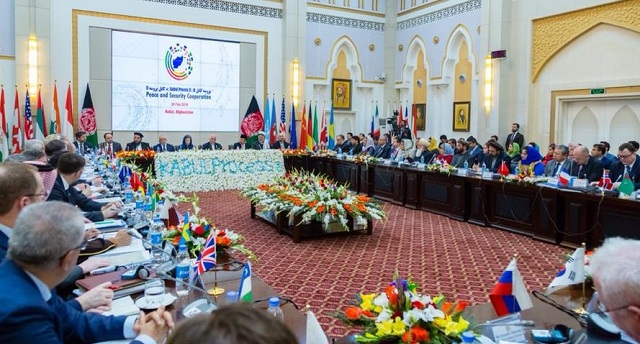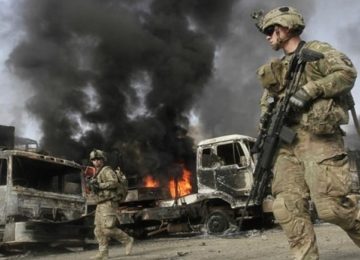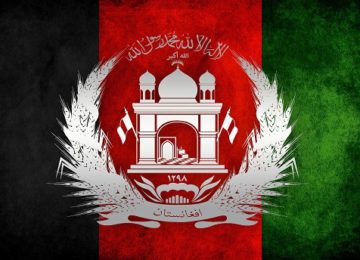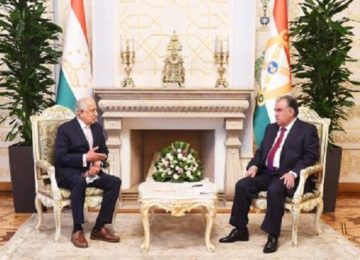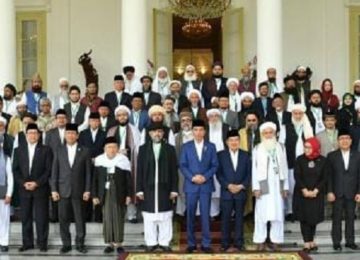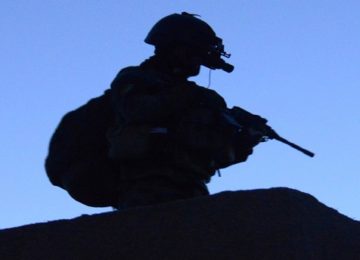The second meeting of the Kabul Process for Peace and Security Cooperation that was held in the Afghan capital on 28 February 2018 marked a change in the peace rhetoric. The Afghan government presented some very concrete proposals for peace talks with the Taleban. It came with a few conditions (not called as such) – mainly that women’s rights and the basic values of the constitution are not up for negotiation. The offer includes, for the first time, a mention of a ceasefire, an office in Kabul for the Taleban and the lifting of sanctions on those Taleban leaders who would join the negotiation. What is not clear is the sequence and over what time period all this would come together.
President Ashraf Ghani’s “comprehensive plan to the Taleban and Pakistan,” as announced in the media in the run-up to the Kabul Process conference (1) was certainly the most complete peace offer that has been publicly announced since 2001.
In his speech, which Ghani consecutively delivered in three languages – English, Dari and Pashto (see transcript here) – the concrete points of what he called “the proposal on behalf of the National Unity Government to the Taleban” came in the Pashto part, addressing the Taleban in the language of the majority of their fighters.
He said that this proposal was offered “without any preconditions,” although he made clear at the same time that the basis for any negotiation would be the current constitution. Nevertheless, at the same time, he offered a partial “review” and “amendment” of it. Previously, the Taleban had rejected the constitution in its entirety and had demanded that a new constitution be drafted, if negotiations were to commence.
Ghani made it very clear, repeatedly throughout his presentation, that the “right and duties of all citizens, in particular the women” must be secured in this process “according to the current constitution.” Women and civil society would also be consulted and included at “each stage” of future negotiations. At least in the run-up to the Kabul meeting, however, this principle apparently was not applied, as Habiba Sarabi, the deputy head of the High Peace Council, can be heard complaining about in this clip posted by daily Etilaat-e Roz.
He also said that any solution must include the guarantee that no “armed group with links to foreign terrorist networks [or] foreign criminal organizations, state or non-state”, would be allowed to seek influence in Afghanistan. This dissociation from al-Qaeda has been a consistent demand of the international community from the Taleban. For the Afghan chapter of the Islamic State, ISKP, however, this would seem to be irrelevant as there is enmity not cooperation on the battlefield, despite some observers claiming the opposite. In any case, it is not difficult for the Taleban to make this statement at this juncture.
What has been proposed?
Ghani’s “peace proposals to the Taleban” have laid out a peace road map (our term, not his). Further down in the text, it is more specifically directed at “Taleban that quit the violence.” It consists of seven points, as follows:
- A “political framework” that includes: a “ceasefire,” the recognition of the Taleban as a political party (siasi gund), confidence-building measures and what he calls free and fair elections;
- A “legal framework” that includes the already-mentioned review of the constitution, the release of Taleban prisoners and the lifting of sanctions;
- It stipulates that: the government of Afghanistan should be officially recognised, the rule of law should be respected, the way should be paved for “reforms, a balanced development” of all regions of the country and the return of refugees;
- It calls for measures to be taken to ensure the security “of all citizens, and in particular of the reconciled Taleban”;
- It foresees that “refugees” [the term used here most likely refers to future returnees] and former fighters should be included in national progammes for social and economic development;
- It envisages that international diplomatic and financial support should be retained, including for determining the fate of foreign fighters and taking reconciled Taleban off the sanctions lists;
- A monitoring and evaluation mechanism should be set up.
Ghani added that the process should be conducted in three phases: negotiations, ratification (taswib) and implementation. He emphasised that in each and every phase women representatives should participate and be consulted. To “Taleban that quit the violence” a “peaceful and respectful life” is offered, Ghani said.
Ghani also said that the National Unity Government (NUG) – in the name of which the proposals are forwarded – had agreed that the Taleban should be offered the means to open an office in Kabul. Passports and the freedom to travel would also be provided to those involved in the negotiations and those accepting peace. In addition, they would be offered support to relocate their families to the country.
He called Kabul “the preferred venue” for talks, but also offered Muslim countries that are not engaged in the conflict (which, in the Afghan view, would exclude Pakistan and possibly hints that Indonesia could be involved – see footnote (1)), “a UN facility or any third country.” In the meantime, Germany has offered to facilitate, or to host peace talks with the Taleban “in Bonn, Berlin or elsewhere” and there are even talks of a “third Bonn conference on Afghanistan” (see tweet of Kabul embassy diplomat here).
Ghani also had a list of suggestions for support that he requested at the international level. He asked for “coordinated international diplomatic support” for this peace effort and “a concerted global effort to persuade Pakistan of the advantages of a stable Afghanistan.” He asked the countries and organisations in the region to align their initiatives with the Kabul Process. In the run-up to the meeting, some key countries had apparently refused to call the Kabul Process an “umbrella process,” under which Kabul wants to see all other peace initiatives operating. (2) Ghani also requested the global Islamic community “to counter the use of interpretations of religious texts as justification of unrestricted war” and terrorist acts. This is a continuation of earlier efforts to persuade Islamic scholars from the country, Pakistan and other Islamic countries to declare Taleban attacks ‘un-Islamic’, something which has received a mixed response so far.
The Afghan president further requested general support “especially” for the “reintegration of refugees and ex-combatants.” This is in the context of his offer to Pakistan of “a consolidated state-to-state dialogue,” which would include “a plan for the return of Afghan refugees from Pakistan within a period of 18 to 24 months.” So far, in the current situation, when Afghanistan is still dealing with around 600,000 returnees from 2016 and 2017, and with about 1.2 million documented refugees still in Pakistan, the UNHCR has only been able to mobilise 9.4 million US dollars – seven per cent – of the amount necessary to pay for already existing and expected returnees in 2018 (see here and here). (3) Finally, Ghani launched an appeal for support for peace-building initiatives through “transit, trade, and investment, the reform and anti-corruption strategy of the government, and the forthcoming 2018 parliamentary and 2019 presidential elections.” He insisted that the parliamentary elections would still be held this year.
A short analysis of the proposal’s content
Ghani’s peace proposals are the most far-reaching move in this field of any Afghan government since 2001 (see AAN dossier on peace talks). Most of what was offered is not new when each element is taken separately. The offer to have peace talks in Kabul, for example, had already been brought up in a statement of the presidential office before the meeting. This said that the government “prefers peace talks with Taliban to take place in Kabul or any other Afghan province.” This statement, in turn, came after a proposal by Akram Khpelwak, head of the High Peace Council (HPC) secretariat from December 2017, inviting the Taleban to open an office in Kabul (see AAN analysis here). However, in this combination, the seven-point proposal does evidently provide a new quality to the offer.
The proposals are not a peace plan yet, though. Such a plan can only materialise through the desired negotiations with the Taleban. Therefore, Ghani announced, the HPC would appoint “a negotiating team, supported by a professional government team,” including women and civil society members, and expressed his hope that the two sides would be able to reach an agreement, “insha’allah,” on an agenda.
It was further noticeable that there was no bellicose rhetoric in the speech. This is in contrast to the run-up to the meeting when Ghani – for example, in a meeting with tribal elders and other Afghan dignitaries five days before – proffered that he would give the Taleban a choice “between peace and war.” (4) It is also evident that this proposal came with no deadline, as had been variously indicated before this meeting. However, given that there is no clear, time-bound sequencing for a broad peace road map (although, for example, the ceasefire comes before the political framework in the seven-proposal list), this perhaps makes sense. This also could be subject to negotiation.
Despite the claim that Ghani’s offers do not carry any preconditions, some of proposals sound like straightforward demands, such as the demand to recognise the Afghan government. Some are even patronising, for example, when it is said, “ideas and opinions and proposals of the Taleban would definitely be considered.” This might be difficult to swallow for the Taleban.
The most striking feature of the peace proposals is that Ghani brings up the idea of a ceasefire. While such a step would be certainly welcomed by most Afghans, it remains open how he plans to get there. It is left open as to whether Ghani expects the Taleban to make the first step, or whether Kabul would do so at some point in time – or whether this needs to be simultaneous in Kabul’s eyes, and would come as a result of a first round of negotiations. Kabul actually could offer such a unilateral step first, given the latest statements – also by the United States commander in Afghanistan – that the tide had been turned against the Taleban (whether this is fully correct or not). This could give it the moral high ground. (5)
The Kabul Process Declaration
The wording of the final declaration of the participating governments and multilateral organisations of the 28 February 2018 Kabul Process meeting (text here) reflects and supports Ghani’s peace offer, although its language is more elusive and general in nature. Participant nations reiterated their support “to the Afghan-led and Afghan-owned peace and reconciliation process” and concur “that direct talks between the Afghan Government and the Taleban—without any preconditions and without the threats of violence—constitute the most viable way to end the ongoing agony of the Afghan people.”
However, it contains one very significant offer: that the Afghan government’s “practical plan for reconciliation” should include the “negotiation of […] any contested aspect of the international community’s future role in Afghanistan.” This is a clear hint that the presence or withdrawal of the foreign troops – surely the most contested aspect – could be dealt with in any future peace talks. It reiterates, at the same time, the Afghan government’s and, more importantly, the US administration’s position that there would be no withdrawal before talks, as has been demanded by the Taleban. This takes the main argument out of their hands; namely, that it needs direct talks with the US to solve that problem. This proposal brings in the US, in any case, whether directly or indirectly.
However, even this positioning is not fully new. The same has already been said by US Secretary of State Rex Tillerson in a speech at the Center for Strategic & International Studies in Washington on 18 October 2017, but this is the first time it has come up in such an official document.
The Taleban’s response
The Taleban reacted surprisingly quickly to the Kabul Process offers. A reply posted on their official website late in the afternoon of 28 February had some positive words for the “peace orientation” of Ghani’s speech.
At the same time, they accused him of “missing the point,” ie their main demand, the withdrawal of the foreign troops. However, this statement came before the Kabul Process meeting’s final declaration that, as published, actually addressed this point. It now remains to be seen what the Taleban will have to say about that. They also stated that they were not interested in “positions and privileges” which, in their view, amounted to “political bribes.”
From rhetoric of peace to peace offer
There has been a definite shift from the previous rhetoric about peace talks to the serious peace offer at the 28 February 2018 Kabul Process meeting. It seems that the Afghan government’s position has changed in quality, moving from general ‘invitations to talk’ to some concrete suggestions (see our 2015 dossier). This might also have to do with president Ghani’s wish, one year before his presidential term ends, to achieve a break-through on peace. He also started his term with a peace initiative (read AAN analysis here).
There are many hurdles to cross for this set of peace proposals beyond the general rejection by the Taleban of any official direct talks with Kabul. This even might be less serious than it seems, as repeated indirect or unofficial contacts have been consistently reported over recent years. Much of this, although not all, used the Taleban’s Qatar office as a point of reference, including contacts by high-ranking Afghan government officials, the UN and non-governmental actors, such as the Pugwash Conference. These contacts, which included discussions of issues such as the Afghan constitution and its possible revision, women’s rights and humanitarian issues, including better measures for the protection of the civilian population in the Afghan war, also showed that the Taleban are at least thinking through some issues. This would make no sense if they did not want to talk at all. This also put their first reaction to the Kabul Process meeting into a somewhat different light.
The peace proposal also comes at a time when Afghan government representatives visiting Saudi Arabia have stated that they are working on closing down the Taleban office in Qatar, which the Taleban have declared to be their only official channel for talks. This would definitely not seem to be a confidence-building measure by the Taleban. It is also not clear whether, when and under which circumstances, Afghan and US forces would tone down their current military offensives to facilitate talks. The US President’s recent “no” to such talks has been explained away by visiting US dignitaries in Kabul as an emotional reaction “after the horrendous week of terrorist attack by the Taliban” in Kabul in late January 2018. Moreover, the US’s support to Ghani’s peace initiative is embodied in their signature under the final declaration of the Kabul Process.
At the same time, there is also a large blank in the proposals and final declaration of the Kabul Process meeting. An implicit amnesty has, in practice, been offered to “another armed group,” as in the 2016 deal with Hezb-e Islami (AAN analysis here). This happens in the context of the International Criminal Court’s on-going deliberations about opening a full-fledged investigation into war crimes and crimes against humanity that have been committed by all parties since 2003. This would also include allegations against the Taleban which feature in the representations of over one million victims to the Court (see AAN analysis here).
The ICC is an independent court and its decision to start an investigation, or not, in Afghanistan cannot be subject to political decisions, such as the peace deal with Hezb, or the one desired with the Taleban. The ICC is concerned with the interest of justice and it leaves the interest of peace to other actors to sort out – even when the two interests seem to be conflicting. As AAN earlier reported, peace – or stability – has usually been sought in Afghanistan with little focus on dealing with the legacies of war crimes. Concrete examples are the failure to identify limits for amnesty in the Afghanistan Peace and Reintegration Programme (APRP) and the adoption of an amnesty law that provides amnesty for all those involved in the last four decades of war in Afghanistan. The lack of truth, the AAN report found, feeds into myths and conflicting narratives about the conflict – its victims, villains and heroes. It will only be by acknowledging the truth that the cycle of violence can be broken and a real process or reconciliation can start. Inevitably, this will be a long process in Afghanistan, but still needs to be an integral part of any sustainable peace process.
(1)The first meeting of the Kabul Process was held in June 2017. As then, the 28 February 2018 meeting came in the wake of increased violence in the capital (see AAN analysis here). The June meeting was overshadowed by the massive truck bomb in Kabul’s Zambaq Square near the German embassy. According to UN figures, this killed 92 civilians and injured 491. This January, Kabul was rattled by another series of attacks. The Taleban and the local chapter of the Islamic State shared responsibility for the violence (see AAN analysis here).
This obviously had an impact on the level of attendants of the meeting. This time, the Afghan government had hoped and planned for those attending to be ministers, then deputy ministers, but had finally had to settle with a “senior officials meeting,” mainly featuring AfPak envoys and ambassadors.
An exception was the Indonesian Vice President, Joseph Kalla. Afghanistan has recently courted the large south-east Asian, Muslim majority nation to act as a mediator in the conflict, but also invited Indonesian ulema to condemn Taleban terrorist acts as ‘un-Islamic’ (more details here). This is something many ulema in the Middle East and Pakistan have avoided doing so far.
(2) There are various bi-, tri- and multilateral initiatives, including those started by Russia, Kazakhstan and other countries (more in this AAN analysis).
(3) There is also an indirect reference to Pakistan’s role and the Taleban’s safe havens there in the final declaration’s second topic that deals with “the fight against terrorism.” It reads that
[…] states must “refrain from organizing, instigating, facilitating, participating in financing, encouraging or tolerating terrorist activities and to take appropriate practical measures to ensure that our respective territories are not used for terrorist installations, or training camps, or for the preparation or organization of terrorist acts intended to be committed by other states or their citizens.”
(4) Five days before the meeting, President Ashraf Ghani told a gathering of tribal elders, jihadi leaders and representatives of provincial councils in Kabul (media report here) that the aim of the meeting – described as “a main forum and vehicle under the leadership of the Afghan Government to guide and steer all peace efforts for ending violence in Afghanistan” – was “to create international consensus on Afghan peace and to see whether or not Taliban want peace.” According to another Afghan media report, he also said at the meeting that his government “… will give them [the Taleban] options to decide, they must think whether they have the intention to surrender to the will of Allah.”
(5) In a parallel development, The New Yorker magazine published an “An Open Letter to the Taleban” by former US negotiator, Barnett Rubin, on the eve of the Kabul Process meeting (here) in which he called upon the Taleban to “challenge Washington and Kabul to accept a temporary ceasefire.” Rubin’s letter is a ‘personal’ reply to a recent Taleban letter to “the American people” and the “peace-loving” members of the US Senate that had been published on 14 February 2018. They followed this up again on 26 February 2018 when they reiterated their stance that they would only talk to the US, not the Kabul government.
By Special Arrangement with AAN. Original link.
Disclaimer: Views expressed on this blog are not necessarily endorsed or supported by the Center for Research and Security Studies, Islamabad.



